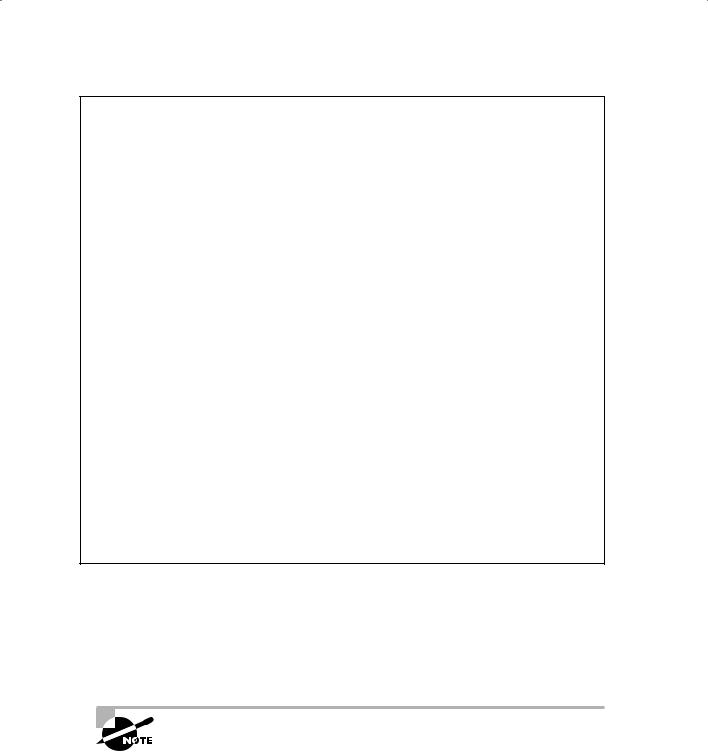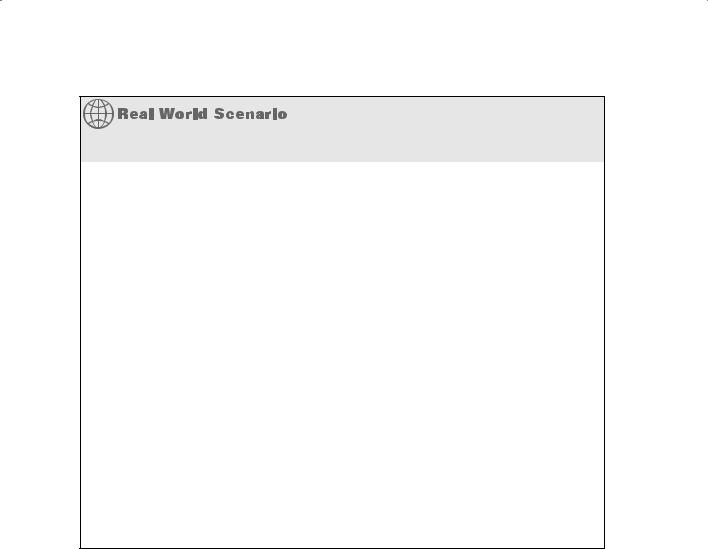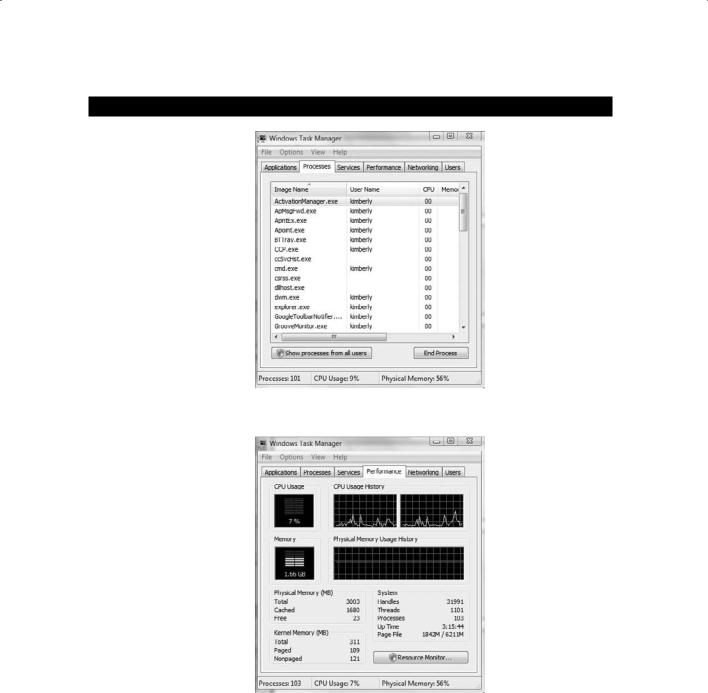
- •Acknowledgments
- •About the Author
- •Contents at a Glance
- •Contents
- •Table of Exercises
- •Introduction
- •Assessment Test
- •Answers to Assessment Test
- •Defining Ethical Hacking
- •How to Be Ethical
- •Keeping It Legal
- •Summary
- •Exam Essentials
- •Review Questions
- •Answers to Review Questions
- •Reconnaissance
- •Information-Gathering Methodology
- •Social Engineering
- •Summary
- •Exam Essentials
- •Review Questions
- •Answers to Review Questions
- •Scanning
- •Enumeration
- •Summary
- •Exam Essentials
- •Review Questions
- •Answers to Review Questions
- •The Simplest Way to Get a Password
- •Types of Passwords
- •Cracking a Password
- •Understanding Keyloggers and Other Spyware Technologies
- •Escalating Privileges
- •Understanding Rootkits
- •Hiding Files
- •Understanding Steganography Technologies
- •Summary
- •Exam Essentials
- •Review Questions
- •Answers to Review Questions
- •Trojans and Backdoors
- •Viruses and Worms
- •Summary
- •Exam Essentials
- •Review Questions
- •Answers to Review Questions
- •How a Sniffer Works
- •Sniffing Countermeasures
- •Bypassing the Limitations of Switches
- •Wireshark Filters
- •Summary
- •Exam Essentials
- •Review Questions
- •Answers to Review Questions
- •Denial of Service
- •Session Hijacking
- •Summary
- •Exam Essentials
- •Review Questions
- •Answers to Review Questions
- •How Web Servers Work
- •Types of Web Server Vulnerabilities
- •Web Application Vulnerabilities
- •Summary
- •Exam Essentials
- •Review Questions
- •Answers to Review Questions
- •SQL Injection
- •Buffer Overflows
- •Summary
- •Exam Essentials
- •Review Questions
- •Answers to Review Questions
- •Wi-Fi and Ethernet
- •Authentication and Cracking Techniques
- •Using Wireless Sniffers to Locate SSIDs
- •MAC Filters and MAC Spoofing
- •Rogue Access Points
- •Wireless Hacking Techniques
- •Securing Wireless Networks
- •Summary
- •Exam Essentials
- •Review Questions
- •Answers to Review Questions
- •Components of Physical Security
- •Understanding Physical Security
- •Physical Site Security Countermeasures
- •What to Do After a Security Breach Occurs
- •Summary
- •Exam Essentials
- •Review Questions
- •Answers to Review Questions
- •Linux Basics
- •Compiling a Linux Kernel
- •GCC Compilation Commands
- •Installing Linux Kernel Modules
- •Linux Hardening Methods
- •Summary
- •Exam Essentials
- •Review Questions
- •Answers to Review Questions
- •Types of IDSs and Evasion Techniques
- •Summary
- •Exam Essentials
- •Review Questions
- •Answers to Review Questions
- •Generating Public and Private Keys
- •Cryptography Algorithms
- •Summary
- •Exam Essentials
- •Review Questions
- •Answers to Review Questions
- •Defining Security Assessments
- •Penetration Testing
- •Pen Test Deliverables
- •Summary
- •Exam Essentials
- •Review Questions
- •Answers to Review Questions
- •Glossary
- •Index

Answers to Review Questions |
123 |
Answers to Review Questions
1.A. Steganography is the process of hiding text within an image.
2.C. A rootkit is a program that modifies the core of the operating system: the kernel and libraries.
3.B. Hackers cover their tracks to keep from having their identity or location discovered.
4.D. Privilege escalation is a hacking method to increase privileges on a user account.
5.A, B. NTFS file streaming and the attrib command are two hacking techniques used to hide files.
6.A. Passwords should be changed every 30 days for the best balance of security and usability.
7.D. A brute-force attack tries every combination of letters, numbers, and symbols.
8.B. Network sniffing is a passive online attack because it can’t be detected.
9.A. The event log must be cleared because the auditpol command places an entry in the event log indicating that logging has been disabled.
10.C. A hardware keylogger is an adapter that connects the keyboard to the PC. A hacker needs physical access to the PC in order to plug in the hardware keylogger.
11.B. The easiest way to get a password is to guess the password. For this reason it is important to create strong passwords and to not reuse passwords.
12.A. elsave is a command used to clear the event log and cover a hacker’s tracks.
13.D. Snow is a steganography program used to hide data within the whitespace of text files.
14.D. The first thing a hacker should do after gaining administrative level access to a system is disable system auditing to prevent detection and attempt to cover tracks.
15.A. Stegdetect is a steganography detection tool.
16.B. LNS is an NTFS countermeasure tool used to detect NTFS streams.
17.B. makestrm.exe is a program used to make NTFS streams.
18.C. It is important to clear the event log after disabling auditing because an entry is created indicating that auditing is disabled.
19.A. A kernel-level rootkit is the most dangerous because it infects the core of the system.
20.B. attrib +h [file/directory] is the command used to hide a file using the hide attribute.


Chapter
5
Trojans, Backdoors,
Viruses, and Worms
CEH Exam Objectives Covered in
This Chapter:
ÛÛWhat is a Trojan?
ÛÛWhat is meant by overt and covert channels?
ÛÛList the different types of Trojans
ÛÛWhat are the indications of a Trojan attack?
ÛÛUnderstand how the “Netcat” Trojan works
ÛÛWhat is meant by “wrapping”?
ÛÛHow do reverse connecting Trojans work?
ÛÛWhat are the countermeasure techniques in preventing Trojans?
ÛÛUnderstand Trojan evading techniques
ÛÛUnderstand the differences between a virus and a worm
ÛÛUnderstand the types of viruses
ÛÛHow a virus spreads and infects a system
ÛÛUnderstand antivirus evasion techniques
ÛÛUnderstand virus detection methods

Trojans and backdoors are two ways a hacker can gain access to a target system. They come in many different varieties, but they all have one thing in common: they must be installed by
another program, or the user must be tricked into installing the Trojan or backdoor on their system. Trojans and backdoors are potentially harmful tools in the ethical hacker’s toolkit and should be used judiciously to test the security of a system or network.
Viruses and worms can be just as destructive to systems and networks as Trojans and backdoors. In fact, many viruses carry Trojan executables and can infect a system, then create a backdoor for hackers. This chapter will discuss the similarities and differences among Trojans, backdoors, viruses, and worms. All of these types of malicious code or malware are important to ethical hackers because they are commonly used by hackers to attack and compromise systems.
Trojans and Backdoors
Trojans and backdoors are types of malware used to infect and compromise computer systems. A Trojan is a malicious program disguised as something benign. In many cases the Trojan appears to perform a desirable function for the user but actually allows a hacker access to the user’s computer system. Trojans are often downloaded along with another program or software package. Once installed on a system, they can cause data theft and loss, as well as system crashes or slowdowns. Trojans can also be used as launching points for other attacks, such as distributed denial of service (DDoS). Many Trojans are used to manipulate files on the victim computer, manage processes, remotely run commands, intercept keystrokes, watch screen images, and restart or shut down infected hosts. Sophisticated Trojans can connect themselves to their originator or announce the Trojan infection on an Internet Relay Chat (IRC) channel.
Trojans ride on the backs of other programs and are usually installed on a system without the user’s knowledge. A Trojan can be sent to a victim system in many ways, such as the following:
NN |
An instant messenger (IM) attachment |
NN |
IRC |
NN |
An email attachment |
|
|
NN |
NetBIOS file sharing |
NN |
A downloaded Internet program |

Trojans and Backdoors |
127 |
Many fake programs purporting to be legitimate software such as freeware, spywareremoval tools, system optimizers, screensavers, music, pictures, games, and videos can install a Trojan on a system just by being downloaded. Advertisements on Internet sites for free programs, music files, or video files lure a victim into installing the Trojan program; the program then has system-level access on the target system, where it can be destructive and insidious.
Table 5.1 lists some common Trojans and their default port numbers.
Ta b l e 5 .1 Common Trojan programs
Trojan |
Protocol |
Port |
|
|
|
BackOrifice |
UDP |
31337 or 31338 |
Deep Throat |
UDP |
2140 and 3150 |
NetBus |
TCP |
12345 and 12346 |
Whack-a-Mole |
TCP |
12361 and 12362 |
NetBus 2 |
TCP |
20034 |
GirlFriend |
TCP |
21544 |
Master’s Paradise |
TCP |
3129, 40421, 40422, 40423, and 40426 |
|
|
|
A backdoor is a program or a set of related programs that a hacker installs on a target system to allow access to the system at a later time. A backdoor can be embedded in a malicious Trojan. The objective of installing a backdoor on a system is to give hackers access into the system at a time of their choosing. The key is that the hacker knows how to get into the backdoor undetected and is able to use it to hack the system further and look for important information.
Adding a new service is the most common technique to disguise backdoors in the Windows operating system. Before the installation of a backdoor, a hacker must investigate the system to find services that are running. Again the use of good information-gathering techniques is critical to knowing what services or programs are already running on the target system. In most cases the hacker installs the backdoor, which adds a new service and gives it an inconspicuous name or, better yet, chooses a service that’s never used and that is either activated manually or completely disabled.
This technique is effective because when a hacking attempt occurs the system administrator usually focuses on looking for something odd in the system, leaving all existing services unchecked. The backdoor technique is simple but efficient: the hacker can get back into the machine with the least amount of visibility in the server logs. The backdoored service lets the hacker use higher privileges—in most cases, as a System account.

128 Chapter 5 n Trojans, Backdoors, Viruses, and Worms
Remote Access Trojans (RATs) are a class of backdoors used to enable remote control over a compromised machine. They provide apparently useful functions to the user and, at the same time, open a network port on the victim computer. Once the RAT is started, it behaves as an executable file, interacting with certain Registry keys responsible for starting processes and sometimes creating its own system services. Unlike common backdoors, RATs hook themselves into the victim operating system and always come packaged with two files: the client file and the server file. The server is installed in the infected machine, and the client is used by the intruder to control the compromised system.
RATs allow a hacker to take control of the target system at any time. In fact one of the indications that a system has been exploited is unusual behavior on the system, such as the mouse moving on its own or pop-up windows appearing on an idle system.
A Word of Caution about Practicing with Trojans
I intentionally left any step-by-step exercises out of this section on Trojans and backdoors because I do not want to advocate anyone installing them on production systems and experiencing loss of data. However, the best way to learn how to use these tools and their capabilities is to install them and test them out. So here is my recommendation to learn ethical hacking skills using Trojans and backdoors.
Take an older computer that you do not have any intention of using again, or buy a second hard drive for your laptop (this is what I did). Install the Windows XP operating system with no service packs or updates enabled. Do not install any virus scanning or firewall. The next step is to really go crazy installing all the Trojans, rootkits, and backdoors tools listed in this chapter. This will give you the freedom to learn and test the tools without being blocked by a virus scan or personal firewall trying to protect your computer. Once you are finished, you can either reinstall Windows or just switch out the hard drive for your production drive.
A final suggestion if you are looking for a small, inexpensive computer to use as a test machine is to purchase an inexpensive netbook that runs Windows XP and use it to install and test tools.
Overt and Covert Channels
An overt channel is the normal and legitimate way that programs communicate within a computer system or network. A covert channel uses programs or communications paths in ways that were not intended.

Trojans and Backdoors |
129 |
Trojans can use covert channels to communicate. Some client Trojans use covert channels to send instructions to the server component on the compromised system. This sometimes makes Trojan communication difficult to decipher and understand. An unsuspecting intrusion detection system (IDS) sniffing the transmission between the Trojan client and server would not flag it as anything unusual. By using the covert channel, the Trojan can communicate or “phone home” undetected, and the hacker can send commands to the client component undetected.
Using a Covert Channel
Jeremiah Denton, a prisoner of war during the Vietnam War, used a covert channel to communicate without his captors’ knowledge. Denton was interviewed by a Japanese TV reporter, and eventually a videotape of the interview made its way to the United States. As American intelligence agents viewed the tape, one of them noticed Denton was blinking in an unusual manner. They discovered he was blinking letters in Morse code. The letters were T-O-R-T-U-R-E, and Denton was blinking them over and over. This is a real-world example of how a covert channel can be used to send a communication message undetected.
Another example of using a computer to convey information via a covert channel is the use a characteristic of a file to deliver information rather that the file itself. A computerbased example of a covert channel is in the creation of a seemingly innocent computer file 16 bytes in size. The file can contain any data as that is not the important information. The file can then be emailed to another person. Again, it seems innocent enough but the real communication is of the number 16. The file size is the important data, not the contents of the file.
Some covert channels rely on a technique called tunneling, which lets one protocol be carried over another protocol. Internet Control Message Protocol (ICMP) tunneling is a method of using ICMP echo-request and echo-reply to carry any payload an attacker may wish to use, in an attempt to stealthily access or control a compromised system. The ping command is a generally accepted troubleshooting tool, and it uses the ICMP protocol. For that reason, many router, switches, firewalls, and other packet filtering devices allow the ICMP protocol to be passed through the device. Therefore, ICMP is an excellent choice of tunneling protocols.

130 Chapter 5 n Trojans, Backdoors, Viruses, and Worms
Hacking Tool
Loki is a hacking tool that provides shell access over ICMP, making it much more difficult to detect than TCPor UDP-based backdoors. As far as the network is concerned, a series of ICMP packets are being sent across the network. However, the hacker is really sending commands from the Loki client and executing them on the server.
Types of Trojans
Trojans can be created and used to perform different attacks. Here are some of the most common types of Trojans:
Remote Access Trojans (RATs) Used to gain remote access to a system. Data-Sending Trojans Used to find data on a system and deliver data to a hacker. Destructive Trojans Used to delete or corrupt files on a system. Denial-of-Service Trojans Used to launch a denial-of-service attack.
Proxy Trojans Used to tunnel traffic or launch hacking attacks via other systems. FTP Trojans Used to create an FTP server in order to copy files onto a system.
Security Software Disabler Trojans Used to stop antivirus software.
How Reverse-Connecting Trojans Work
Reverse-connecting Trojans let an attacker access a machine on the internal network from the outside. The hacker can install a simple Trojan program on a system on the internal network, such as the reverse WWW shell server. On a regular basis (usually every 60 seconds), the internal server tries to access the external master system to pick up commands. If the attacker has typed something into the master system, this command is retrieved and executed on the internal system. The reverse WWW shell server uses standard HTTP. It’s dangerous because it’s difficult to detect: it looks like a client is browsing the Web from the internal network.
Hacking Tools
TROJ_QAZ is a Trojan that renames the application notepad.exe file to note.com and then copies itself as notepad.exe to the Windows folder. This will cause the Trojan to be launched every time a user runs Notepad. It has a backdoor that a remote user or hacker can use to connect to and control the computer using port 7597. TROJ_QAZ also infects the Registry so that it is loaded every time Windows is started.

Trojans and Backdoors |
131 |
Tini is a small and simple backdoor Trojan for Windows operating systems. It listens on port 7777 and gives a hacker a remote command prompt on the target system. To connect to a Tini server, the hacker telnets to port 7777.
Donald Dick is a backdoor Trojan for Windows OSs that allows a hacker full access to a system over the Internet. The hacker can read, write, delete, or run any program on the system. Donald Dick also includes a keylogger and a Registry parser, and can perform functions such as opening or closing the CD-ROM tray. The attacker uses the client to send commands to the victim listening on a predefined port. Donald Dick uses default port 23476 or 23477.
NetBus is a Windows GUI Trojan program and is similar in functionality to Donald Dick. It adds the Registry key HKEY_CURRENT_USER\NetBus Server and modifies the HKEY_CURRENT_USER\ NetBus Server\General\TCPPort key. If NetBus is configured to start automatically, it adds a Registry entry called NetBus Server Pro in HKEY_LOCAL_MACHINE\Software\Microsoft\ Windows\CurrentVersion\RunServices.
SubSeven is a Trojan that can be configured to notify a hacker when the infected computer connects to the Internet and can tell the hacker information about the system. This notification can be done over an IRC network, by ICQ, or by email. SubSeven can cause a system to slow down, and generates error messages on the infected system.
Back Orifice 2000 is a remote administration tool that an attacker can use to control a system across a TCP/IP connection using a GUI interface. Back Orifice doesn’t appear in the task list or list of processes, and it copies itself into the Registry to run every time the computer is started. The filename that it runs is configurable before it’s installed. Back Orifice modifies the HKEY_LOCAL_MACHINE\SOFTWARE\Microsoft\Windows\CurrentVersion\RunServices
Registry key. BackOrifice plug-ins add features to the BackOrifice program. Plug-ins include cryptographically strong Triple DES encryption, a remote desktop with optional mouse and keyboard control, drag-and-drop encrypted file transfers, Explorer-like file system browsing, graphical remote Registry editing, reliable UDP and ICMP communications protocols, and stealth capabilities that are achieved by using ICMP instead of TCP and UDP.
BoSniffer appears to be a fix for Back Orifice but is actually a Back Orifice server with the SpeakEasy plug-in installed. If BoSniffer.exe, the BoSniffer executable, is run on a target system, it attempts to log on to a predetermined IRC server on channel #BO_OWNED with a random username. It then proceeds to announce its IP address and a custom message every few minutes so that the hacker community can use this system as a zombie for future attacks.
ComputerSpy Key Logger is a program that a hacker can use to record computer activities on a computer, such as websites visited; logins and passwords for ICQ, MSN, AOL, AIM, and Yahoo! Messenger or webmail; current applications that are running or executed; Internet chats; and email. The program can even take snapshots of the entire Windows desktop at set intervals.

132 Chapter 5 n Trojans, Backdoors, Viruses, and Worms
Beast is a Trojan that runs in the memory allocated for the WinLogon.exe service. Once installed, the program inserts itself into Windows Explorer or Internet Explorer. One of Beast’s most distinct features is that it’s an all-in-one Trojan, meaning the client, the server, and the server editor are stored in the same application.
CyberSpy is a telnet Trojan that copies itself into the Windows system directory and registers itself in the system Registry so that it starts each time an infected system is rebooted. Once this is done, it sends a notice via email or ICQ and then begins to listen to a previously specified TCP/IP port.
Subroot is a remote administration Trojan that a hacker can use to connect to a victim system on TCP port 1700.
LetMeRule! is a remote access Trojan that can be configured to listen on any port on a target system. It includes a command prompt that an attacker uses to control the target system. It can delete all files in a specific director, execute files at the remote host, or view and modify the Registry.
Firekiller 2000 disables antivirus programs and software firewalls. For instance, if Norton AntiVirus is in auto scan mode in the Taskbar, and AtGuard Firewall is activated, the program stops both on execution and makes the installations of both unusable on the hard drive. They must then be reinstalled to restore their functionality. Firekiller 2000 works with all major protection software, including AtGuard, Norton AntiVirus, and McAfee Antivirus.
The Hard Drive Killer Pro programs offer the ability to fully and permanently destroy all data on any given DOS or Windows system. The program, once executed, deletes files and infects and reboots the system within a few seconds. After rebooting, all hard drives attached to the system are formatted in an unrecoverable manner within only one to two seconds, regardless of the size of the hard drive.
How the Netcat Trojan Works
Netcat is a Trojan that uses a command-line interface to open TCP or UDP ports on a target system. A hacker can then telnet to those open ports and gain shell access to the target system. Exercise 5.1 shows you how to use Netcat.
For the CEH exam, it’s important to know how to use Netcat. Make sure you download the Netcat tool and practice the commands before attempting the exam.

Trojans and Backdoors |
133 |
E x e r c i s e 5 .1
Using Netcat
Download a version of Netcat for your system. There are many versions of Netcat for all Windows OSs. Also, Netcat was originally developed for the Unix system and is available in many Linux distributions, including BackTrack.
Netcat needs to run on both a client and the server. The server side of the connection in enabled by the -l attribute and is used to create a listener port. For example, use the following command to enable the Netcat listener on the server:
nc -L -p 123 -t -e cmd.exe
On the Netcat client, run the following command to connect to the Netcat listener on the server:
nc <ip address of the server> <listening port on the server>
The client should then have a command prompt shell open from the server.
Unusual system behavior is usually an indication of a Trojan attack. Actions such as programs starting and running without the user’s initiation; CD-ROM drawers opening or closing; wallpaper, background, or screen saver settings changing by themselves; the screen display flipping upside down; and a browser program opening strange or unexpected websites are all indications of a Trojan attack. Any action that is suspicious or not initiated by the user can be an indication of a Trojan attack.

134 Chapter 5 n Trojans, Backdoors, Viruses, and Worms
Indications of a Virus or Trojan Infection
Carrie was using her computer at work and noticed that her computer seemed to be running slowly. When she tried to open files in Microsoft Word, her system would give an error message and then she was unable to use certain functions in the program. She had not received any new email messages in the last 24 hours; she usually received 50 or so messages per day, so this seemed a bit unusual. Lastly, a client of hers had said he received duplicate emails from her last week, which seemed odd.
So, Carrie called John, the company network administrator, and asked him to look at her computer to determine what was causing the computer slowdown and other issues with Microsoft Outlook. John looked at Carrie’s computer and noticed that the virus definitions were 6 months old. The antivirus program kept popping up with windows indicating that the virus definitions were out of date, but Carrie just ignored them and kept closing the pop-up windows. John updated the antivirus definitions and ran a full system scan. The antivirus program determined that the system had been infected with 114 viruses and Trojans. The antivirus program was able to clean the infections and restore the computer to its previous uninfected state. John was testing Microsoft Outlook to ensure that it was indeed working when he noticed several emails from online horoscope services, entertainment websites, and online gaming websites. John removed several questionable programs from her computer. Apparently, Carrie did not realize that these types of downloads could cause harm to her computer.
Network software to push virus updates to all workstations, network controls to prevent installation of unauthorized software, and user security awareness training could have prevented this incident from occurring.
Wrappers are software packages that can be used to deliver a Trojan. The wrapper binds a legitimate file to the Trojan file. Both the legitimate software and the Trojan are combined into a single executable file and installed when the program is run.
Generally, games or other animated installations are used as wrappers because they entertain the user while the Trojan in being installed. This way, the user doesn’t notice the slower processing that occurs while the Trojan is being installed on the system—the user only sees the legitimate application being installed.

Trojans and Backdoors |
135 |
Hacking Tools
Graffiti is an animated game that can be wrapped with a Trojan. It entertains the user with an animated game while the Trojan is being installed in the background.
Silk Rope 2000 is a wrapper that combines the BackOrifice server and any other specified application.
ELiTeWrap is an advanced EXE wrapper for Windows used for installing and running programs. ELiTeWrap can create a setup program to extract files to a directory and execute programs or batch files that display help menus or copy files on to the target system.
Icon Converter Plus is a conversion program that translates icons between various formats. An attacker can use this type of application to disguise malicious code or a Trojan so that users are tricked into executing it, thinking it is a legitimate application.
Trojan Construction Kit and Trojan Makers
Several Trojan-generator tools enable hackers to create their own Trojans. Such toolkits help hackers construct Trojans that can be customized. These tools can be dangerous and can backfire if not executed properly. New Trojans created by hackers usually have the added benefit of passing undetected through virus-scanning and Trojan-scanning tools because they don’t match any known signatures.
Some of the Trojan kits available in the wild are Senna Spy Generator, the Trojan Horse Construction Kit v2.0, Progenic Mail Trojan Construction Kit, and Pandora’s Box.
Trojan Countermeasures
Most commercial antivirus program have anti-Trojan capabilities as well as spyware detection and removal functionality. These tools can automatically scan hard drives on startup to detect backdoor and Trojan programs before they can cause damage. Once a system is infected, it’s more difficult to clean, but you can do so with commercially available tools. Although several commercially antivirus or Trojan removal tools are available, my personal recommendation is Norton Internet Security (Figure 5.1). Norton Internet Security includes a personal firewall, intrusion detection system, antivirus, antispyware, antiphishing, and email scanning. Norton Internet Security will clean most Trojans from a system as well.

136 Chapter 5 n Trojans, Backdoors, Viruses, and Worms
F i g u r e 5 .1 Norton Internet Security

Trojans and Backdoors |
137 |
The security software works by having known signatures of malware, such as Trojans and viruses. The repair for the malware is made through the use of definitions of the malware. When installing and using any personal security software or antivirus and anti-Trojan software, you must make sure that the software has all the current definitions. To ensure the latest patches and fixes are available, you should connect the system to the Internet so the software can continually update the malware definitions and fixes.
It’s important to use commercial applications to clean a system instead of freeware tools, because many freeware removal tools can further infect the system. In addition, a lot of commercial security software includes an intrusion detection component that will perform port monitoring and can identify ports that have been opened or files that have changed.
The key to preventing Trojans and backdoors from being installed on a system is to educate users not to install applications downloaded from the Internet or open email attachments from parties they don’t know. Many system administrators don’t give users the system permissions necessary to install programs on their system for that very reason. Proper use of Internet technologies should be included in regular employee security awareness training.
Port-Monitoring and Trojan-Detection Tools
Fport reports all open TCP/IP and UDP ports and maps them to the owning application. You can use fport to quickly identify unknown open ports and their associated applications.
TCPView is a Windows program that shows detailed listings of all TCP and UDP endpoints on the system, including the local and remote addresses and state of TCP connections. When TCPView runs, it enumerates all active TCP and UDP endpoints, resolving all IP addresses to their domain name versions.
PrcView is a process viewer utility that displays detailed information about processes running under Windows. PrcView comes with a command-line version you can use to write scripts that check whether a process is running and, if so, kill it.
Inzider is a useful tool that lists processes in the Windows system and the ports on which each one listens. Inzider may pick up some Trojans. For instance, BackOrifice injects itself into other processes, so it isn’t visible in the Task Manager as a separate process, but it does have an open port that it listens on.
Tripwire verifies system integrity. It automatically calculates cryptographic hashes of all key system files or any file that is to be monitored for modifications. The Tripwire software works by creating a baseline snapshot of the system. It periodically scans those files, recalculates the information, and sees whether any of the information has changed. If there is a change, the software raises an alarm.

138 Chapter 5 n Trojans, Backdoors, Viruses, and Worms
Dsniff is a collection of tools used for network auditing and penetration testing. Dsniff, filesnarf, mailsnarf, msgsnarf, urlsnarf, and WebSpy passively monitor a network for interesting data such as passwords, email, and file transfers. Arpspoof, dnsspoof, and macof facilitate the interception of network traffic normally unavailable to an attacker due to Layer 2 switching. Sshmitm and webmitm implement active man-in-the-middle attacks against redirected Secure Shell (SSH) and HTTP Over SSL (HTTPS) sessions by exploiting weak bindings in ad hoc Public Key Infrastructure (PKI). These tools will be discussed in further detail in Chapter 6, “Gathering Data from Networks: Sniffers.”
Checking a System with System File Verification
Windows 2003 includes a feature called Windows File Protection (WFP) that prevents the replacement of protected files. WFP checks the file integrity when an attempt is made to overwrite a SYS, DLL, OCX, TTF, or EXE file. This ensures that only Microsoft-verified files are used to replace system files.
Another tool, sigverif, checks to see what files Microsoft has digitally signed on a system. In Exercise 5.2, we will use this tool.
E x e r c i s e 5 . 2
Signature Verification
We will run sigverif, a signature verification checker, and compare the results to the currently running processes in Task Manager:
1.Press Ctrl+Alt+Del and select Start Task Manager.
2.Click the Processes tab. Note any unusual processes and the amount of CPU time they are using. Any processes using a consistently high percentage of CPU time may indicate a virus or Trojan infection.

Trojans and Backdoors |
139 |
E x e r c i s e 5 . 2 ( c o n t i n u e d )
3.Click the Performance tab in Task Manager to view the current CPU usage.
4.Click Start Run.

140 Chapter 5 n Trojans, Backdoors, Viruses, and Worms
E x e r c i s e 5 . 2 ( c o n t i n u e d )
5.Type sigverif, and click Start.
6.In the sigverif program, choose Advanced to see the signature verification report.
